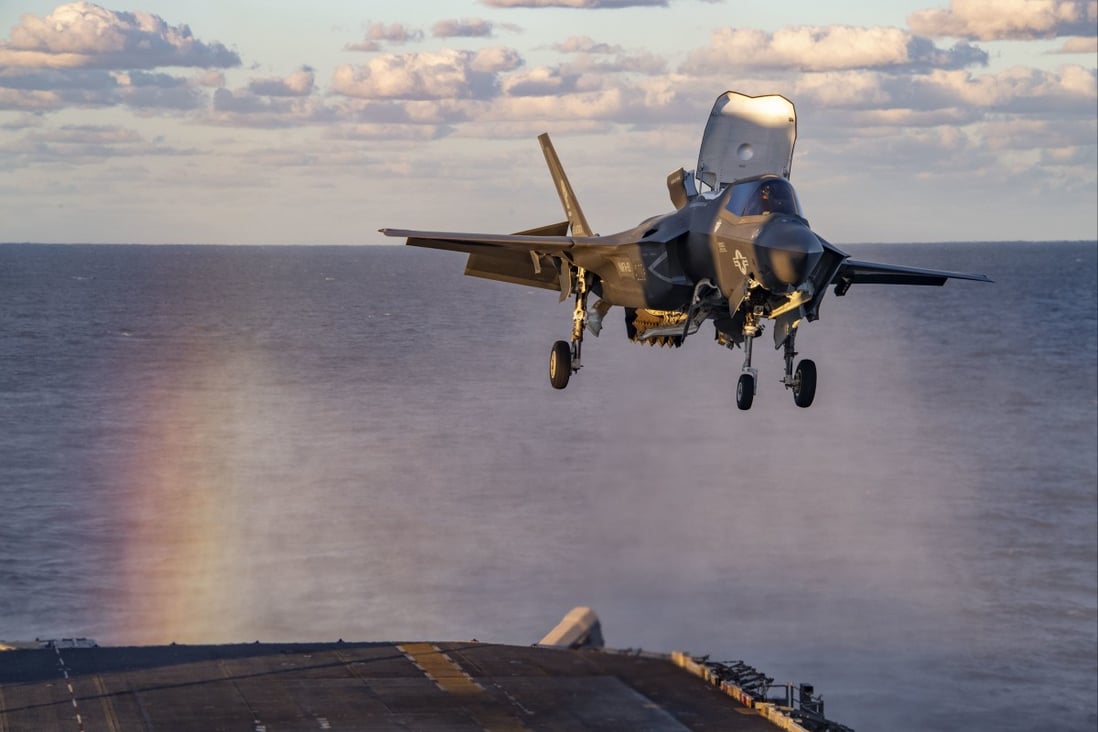
‘Lightning carrier concept’: lessons for China in US Navy’s use of amphibious ships as small carriers
- During
naval exercises in March and April, the US operated F-35B Lightning II
jets from an amphibious assault carrier for the first time
- Military
analysts suggest China learn from the tactic both for its own navy and
also to assess how an enemy might coordinate during a strike
Beijing should keep a close eye on a new naval combat concept demonstrated by the US that can turn amphibious ships into small aircraft carriers, adding power and flexibility to the nation’s navy, say analysts.
The “Lightning carrier concept” was demonstrated by the US Navy and Marine Corps in an exercise from March 30 to April 8 when 20 of its F-35B Lightning II jets were operated from an amphibious assault carrier – the America-class USS Tripoli – for the first time, according to a release by the Marine Corps.
The display showed that the US military could operate amphibious assault carriers with fifth-generation aircraft, turning the ships into smaller aircraft carriers.
The approach was incrementally developed on an earlier strategy, which used amphibious assault ships to support AV-8B Harriers, a single-engine ground-attack aircraft capable of vertical or short take-off and landing.
Also capable of vertical take-off and landing, the F-35B is a single-seat, single-engine, all-weather stealth multirole combat aircraft intended to both assert air superiority and perform strike missions.
Combining multi-role air-superiority fighter jets with an assault ship would give the US more options when employing sea-based air power, said James Bosbotinis, a specialist in defence and international affairs.
Bosbotinis said the Lightning carrier concept sought to use the enhanced aviation facilities of the new America-class amphibious assault ships to support an air group of F-35Bs, in contrast to the usual mix of helicopters, assault support aircraft and fighter jets.
“A Lightning carrier could supplement US Navy carrier operations in a particular area, or serve as an alternative to a carrier if the latter is not required or available,” said Bosbotinis, adding that the Lightning carrier concept could provide additional decks for the US as the country looks to develop a distributed naval power.
Bosbotinis noted that the tactic was valuable for other navies.
“For example, Australia operates a pair of amphibious assault ships, the Canberra-class, which could be upgraded to support the F-35B,” he said.
“China is building amphibious assault ships similar to the USS America-class, the Type 075, which could theoretically operate in a manner similar to the Lightning carrier concept. However, China is not believed to be developing a short take-off and vertical landing aircraft akin to the F-35B.”
China’s fifth-generation fighter jet, the J-20, is a twinjet all-weather stealth fighter but, unlike the F-35, it cannot perform short take-offs and vertical landings.
China has three Type 075 amphibious assault ships, with its second commissioned in April. Despite having fewer large vessels, China has the world’s largest navy fleet, relying disproportionately on smaller classes of ships.
Zhou Chenming, a researcher from the Yuan Wang military science and technology think tank in Beijing, said the Lightning carrier strategy held lessons for China, especially showing how different military units could coordinate in a strike.
“This is a threatening concept. Beijing should carefully watch if the US uses this tactic to advance its interests and go against China, like in the South China Sea region,” Zhou said.
The US has 11 aircraft carriers and eight amphibious assault ships, all regularly sailing around the world. The USS Ronald Reagan, a Nimitz-class nuclear-powered supercarrier, has returned to the South China Sea following a five-day port call to Singapore, departing Changi Naval Base on Tuesday.
It comes amid worsening ties between the US and China, with a potential visit by US House Speaker Nancy Pelosi to Taiwan, the self-ruled island Beijing claims as its own and has vowed to take control of, by force if necessary.




No comments:
Post a Comment
Note: Only a member of this blog may post a comment.